Inside Story
The "taste" of a high-end camera
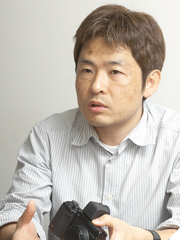
"When we did the design, we were
always thinking about the fact that
more units will be developed in the
future." (Masahiro Kurita)
The GXR name of this unprecedented new camera system was derived from two Ricoh bloodlines: The GX camera line which rivals a "Swiss Army knife" in its range of multipurpose functions and the XR SLR camera line which Ricoh sold in the film camera era. "To give the GXR a high-class and high-dependability feel worthy of a tool that people will love to use, for the exterior we utilized a magnesium alloy with a non-slip "pear-skin" baked finish. So that people will want to continue to use the GXR body along with the new units to be introduced in the future, we endeavored to create a user-friendly design that photographers will never tire of," said design leader Masahiro Kurita from the Product Design Office in the Corporate Design Center of the Corporate Planning Division.
"We obsessed over the grip; we agonized over the grip," said Kurita. To insure that it will be possible to firmly grip the GXR even when large camera units are attached, a number of mockups were made and various people tried holding them. "Having to keep in mind the units that will be developed in the future added a new level of difficulty that we had not faced before. It was also very hard to bring together the final design in a way that did not adversely impact the compact size of the body," Kurita noted.
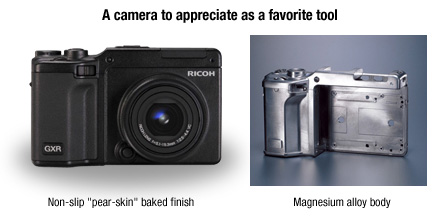
Three-inch LCD screen and superior operability
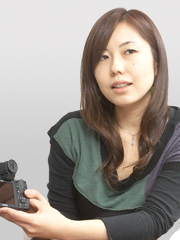
"The DIRECT button has enhanced
GXR operability." (Mayu Takano)
A focus ring has been added to the 50 mm lens, and seamless switching between AF (auto focus) and MF (manual focus) is possible. After doing AF focusing by pressing the shutter release button halfway, you can fine tune the focus by turning the focus ring. With the operation buttons, LCD screen, and other features designed based on a premise of interchangeable units, the excellent usability of past models has been maintained and even enhanced.
This is particularly true of the DIRECT screen, which was designed to make the most of the GXR's inherent flexibility. Pressing the DIRECT button displays the current shooting settings. Background image density can be changed by just pressing a single button so you can simultaneously check both the image and the settings. "The photographer can check and change settings while framing. Our goal was to maintain past levels of operability while at the same time providing an intuitive operability that would not impair GXR flexibility," said Mayu Takano, screen design leader from the Interaction Design Office in Corporate Design Center of the Corporate Planning Division.
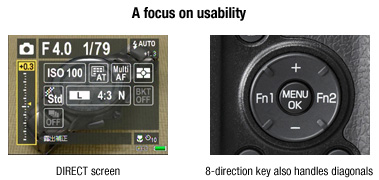
There is extra space on the screen for use by new units planned for the future. "Until now a 4-direction pad was used for AE/AF target shift, selecting images from thumbnails, and other functions, but selection is now easier and smoother using the GXR 8-direction pad, which also handles diagonal movement. The especially difficult task that we faced with the GXR was to keep the excellent operability that people are accustomed to on Ricoh cameras while at the same time insuring that the GXR body has the future potential needed to handle a diverse range of other units going forward," explained Takano.
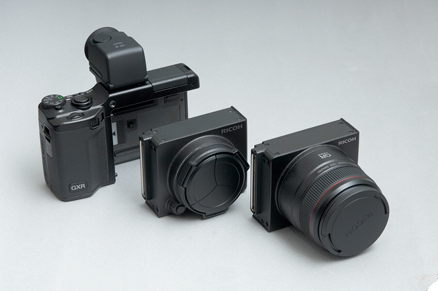
GXR Interchangeable unit camera system
Looking to the future and proposing new ways to enjoy photography
When the start of sales was announced, the GXR was covered in many media and generated a strong response from camera users. So that people could learn about this new camera system, we created a special site on the Web. Many users reserved their GXRs before sales actually started, and after the sales start on December 18, 2009, we quickly received many reactions from users, such as "With the GXR, I can easily take the shot without asking the subject to stop and pose," "We have entered an era when it is enough to carry just a compact camera," and "Now I can take the pictures that I could not take before with a compact!"
We were also asked the question: "What kind of camera units are you going to put out next?" With regard to such future plans, Okamoto said, "The devices that can be mounted on the GXR body are not limited to camera units consisting of a lens and image sensor." He added, "We want to give the GXR expandability that goes beyond the world of the camera to include such things as a projector unit to project images, a compact color printer unit, and more. To achieve this, our design and development staff have pushed beyond the boundaries of our past work."—— Next time we will take a look at the future direction of the GXR and at the kinds of challenges faced up till now in its design and development.
- *Lens focal lengths in the text are all converted to 35 mm film camera equivalents.
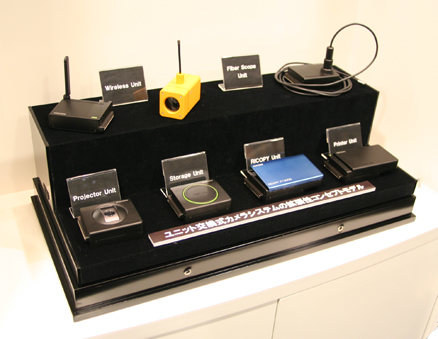
Concept models for units planned for the future.
The world of the GXR will continue to grow with a variety of units such as projectors and printers. (Photo shows a display currently at RING CUBE gallery)


